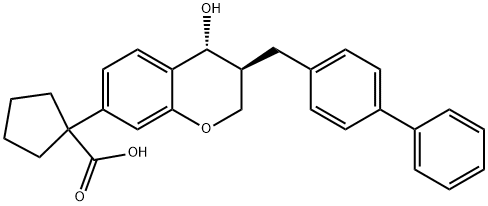158081-99-3
 158081-99-3 結(jié)構(gòu)式
158081-99-3 結(jié)構(gòu)式
基本信息
化合物 CP-105696
1-((3S,4R)-3-([1,1'-聯(lián)苯]-4-基甲基)-4-羥基苯并二氫吡喃-7-基)環(huán)戊烷-1-甲酸
Pfizer 105696
UNII-Z7354TW4BM
CP-105,696 >=98% (HPLC)
CP 105696
CP105696
CP-105696
UNII-Z7354TW4BM
PFIZER 105696
1-((3S,4R)-3-([1,1'-biphenyl]-4-ylmethyl)-4-hydroxychroman-7-yl)cyclopentane-1-carboxylic acid
1-[(3S,4R)-4-hydroxy-3-[(4-phenylphenyl)methyl]-3,4-dihydro-2H-chromen-7-yl]cyclopentane-1-carboxylic acid
Cyclopentanecarboxylic acid, 1-[(3S,4R)-3-([1,1'-biphenyl]-4-ylmethyl)-3,4-dihydro-4-hydroxy-2H-1-benzopyran-7-yl]-
物理化學(xué)性質(zhì)
常見問題列表
|
LTB 4 8.42±0.26 nM (IC 50 ) |
CP-105696 is a structurally novel, selective and potent LTB 4 receptor antagonist. In vitro, CP-105696 inhibits [ 3 H]LTB 4 (0.3 nM) binding to high-affinity LTB 4 receptors on human neutrophils with an lC 50 value of 8.42±0.26 nM. Scatchard analyses of [ 3 H]LTB 4 binding to these high-affinity receptors indicate that CP-105696 acts as a noncompetitive antagonist. CP-105696 inhibits human neutrophil chemotaxis mediated by LTB 4 (5 nM) in a noncompetitive manner with an IC 50 value of 5.0±2.0 nM. Scatchard analyses of [ 3 H]LTB 4 binding to low-affinity receptors on neutrophils indicate that CP-105696 acts as a competitive antagonist at this receptor, and inhibition of LTB 4 -mediated CD11b upregulation on human neutrophils is competitively inhibited by CP-105696 (pA 2 =8.03±0.19). CP-105696 at 10 μM does not inhibit either human neutrophil chemotaxis or CD11b upregulation mediated through alternate (i.e., C5a, lL-8, PAF) G-protein coupled chemotactic factor receptors. In isolated human monocytes, LTB 4 (5 nM)-mediated Ca 2+ mobilization is inhibited by CP-105696 with an lC 50 value of 940±70 nM.
At a dose of 50 mg/kg/day (28 days), B10.BR (H2k) allografts transplanted into C57Bl/6 (H2b) recipients are significantly protected, as reflected by the mean survival time versus control grafts (27±20 days [n=10] vs. 12±6 days [n=14]; P=0.0146). Using an induction protocol (day -1 to day 3), CP-105696 at 100 mg/kg/day significantly prolongs allograft survival (33±23 days [n=9]; P=0.0026), but CP-105696 at 10 mg/kg/day does not (18±16 days [n=8]; P=0.1433). Syngeneic grafts survive indefinitely (n=11). Immunohistological evaluation of allografts at rejection reveals a mononuclear cell infiltrate composed primarily of CD3+ and CD11b+ (Mac-1+) cells, which are infrequent in syngeneic grafts. Allografts from mice treated with CP-105696 at 50 or 100 mg/kg/day demonstrat a selective reduction in β2-integrin (Mac-1) expression on monocytes/macrophages, as demonstrated by CD11b staining density compared with allograft controls.
